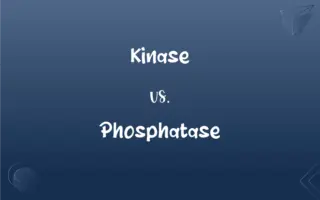Genes vs. Chromosomes: What's the Difference?
Edited by Harlon Moss || By Janet White || Published on November 10, 2023
Genes are segments of DNA that code for specific traits, while chromosomes are long structures containing numerous genes and regulating genetic information.

Key Differences
Genes are specific sequences of nucleotides in DNA that carry the instructions for producing proteins, which, in turn, influence individual traits and functions in an organism. They are akin to blueprints that determine characteristics like eye color, height, and susceptibility to certain diseases. On the other hand, chromosomes are organized structures consisting of DNA and proteins. They hold the genetic information of an organism in a compact and efficient manner.
Every living organism has a unique set of genes that dictates its biological makeup and functionality. These genes reside within the DNA strands that make up the chromosomes. In contrast, chromosomes are found in the nucleus of cells and come in pairs; humans, for instance, have 23 pairs, totaling 46 chromosomes. Each chromosome contains numerous genes, which together dictate the organism's genetic makeup.
Genes are the fundamental units of heredity. When offspring are produced, genes from both parents combine to determine the traits of the offspring. These genes dictate everything from hair color to predispositions to certain conditions. Chromosomes, on the other hand, play a pivotal role during cell division, ensuring that DNA is replicated and distributed accurately into daughter cells.
The function and importance of genes and chromosomes intertwine in the realm of genetics. While genes carry the vital instructions for life, chromosomes serve as the repositories for these instructions. Both genes and chromosomes interact to influence the growth, development, and functioning of all living organisms.
Comparison Chart
Definition
Segments of DNA coding for specific traits.
Structures containing numerous genes.
ADVERTISEMENT
Function
Code for proteins affecting traits.
Organize and regulate genetic information.
Location
Within DNA strands on chromosomes.
In the nucleus of cells.
Number
Varies widely (thousands in humans).
Fixed for species (46 in humans).
Role in Heredity
Basic units determining traits.
Ensure correct gene distribution during reproduction.
Genes and Chromosomes Definitions
Genes
Blueprint for growth and development.
The growth rate in plants is influenced by certain genes.
ADVERTISEMENT
Chromosomes
Structures holding genetic information.
Human cells typically contain 46 chromosomes.
Genes
DNA segments that determine individual traits.
Eye color is influenced by multiple genes.
Chromosomes
DNA-protein complexes in the nucleus.
Each cell's nucleus houses its chromosomes.
Genes
Factors determining susceptibility to conditions.
Certain genes increase the risk of developing heart disease.
Chromosomes
Carriers of genes in organized manner.
Genes are located along the length of chromosomes.
Genes
Units of hereditary information.
Certain genes are passed from parents to offspring.
Chromosomes
Come in species-specific numbers.
Fruit flies have 8 chromosomes, while humans have 46.
Genes
Sequences that code for proteins.
The production of hemoglobin is directed by specific genes.
Chromosomes
Vital for accurate DNA distribution during cell division.
During mitosis, chromosomes ensure DNA replication and segregation.
Genes
A hereditary unit consisting of a sequence of DNA that occupies a specific location on a chromosome and is transcribed into an RNA molecule that may function directly or be translated into an amino acid chain. Genes undergo mutation when their DNA sequences change.
Chromosomes
A linear strand of DNA and associated proteins in the nucleus of eukaryotic cells that carries the genes and functions in the transmission of hereditary information.
Genes
Plural of gene
Chromosomes
A circular strand of DNA in bacteria and archaea that contains the hereditary information necessary for cell life.
Chromosomes
Plural of chromosome
FAQs
How many chromosomes do humans have?
Humans have 46 chromosomes, arranged in 23 pairs.
Can genes influence health conditions?
Yes, certain genes can determine susceptibility to specific diseases.
What are genes responsible for?
Genes code for specific traits and functions in an organism.
Are genes larger than chromosomes?
No, genes are segments within the much larger chromosomes.
What is the purpose of chromosomes during cell division?
Chromosomes ensure accurate replication and distribution of DNA during cell division.
Where are chromosomes located in a cell?
Chromosomes are found in the cell's nucleus.
How do chromosomes play a role in inheritance?
Chromosomes carry genes and ensure their accurate distribution during reproduction.
Are all genes active at all times?
No, genes can be turned on or off based on various factors.
Can genes be edited or modified?
Yes, with techniques like CRISPR, genes can be edited.
How do genes impact an organism's physical appearance?
Genes code for proteins that determine traits like eye color, height, and more.
Can genes be shared across species?
Yes, some genes are conserved and can be found in various species.
Why do siblings have different traits if they share chromosomes from the same parents?
While they share chromosomes, the specific combination of genes they inherit can vary.
Can genes determine behavior?
Genes can influence predispositions, but behavior is a complex interplay of genes and environment.
How are chromosomes visualized in a lab?
Using techniques like karyotyping, chromosomes can be visualized and studied.
Can genes be patented?
Historically, yes, but recent rulings have made it harder to patent naturally occurring genes.
What structures hold chromosomes together?
Centromeres hold sister chromatids of chromosomes together.
How do chromosomes vary among species?
Different species have different numbers and structures of chromosomes.
How do chromosomes determine gender in humans?
The 23rd pair of chromosomes determines gender; XX for females and XY for males.
What happens if chromosomes don't separate properly during cell division?
Improper separation can lead to conditions like Down syndrome.
Are genes solely responsible for determining traits?
While genes play a crucial role, environment and interactions can also influence traits.
About Author
Written by
Janet WhiteJanet White has been an esteemed writer and blogger for Difference Wiki. Holding a Master's degree in Science and Medical Journalism from the prestigious Boston University, she has consistently demonstrated her expertise and passion for her field. When she's not immersed in her work, Janet relishes her time exercising, delving into a good book, and cherishing moments with friends and family.
Edited by
Harlon MossHarlon is a seasoned quality moderator and accomplished content writer for Difference Wiki. An alumnus of the prestigious University of California, he earned his degree in Computer Science. Leveraging his academic background, Harlon brings a meticulous and informed perspective to his work, ensuring content accuracy and excellence.







































































